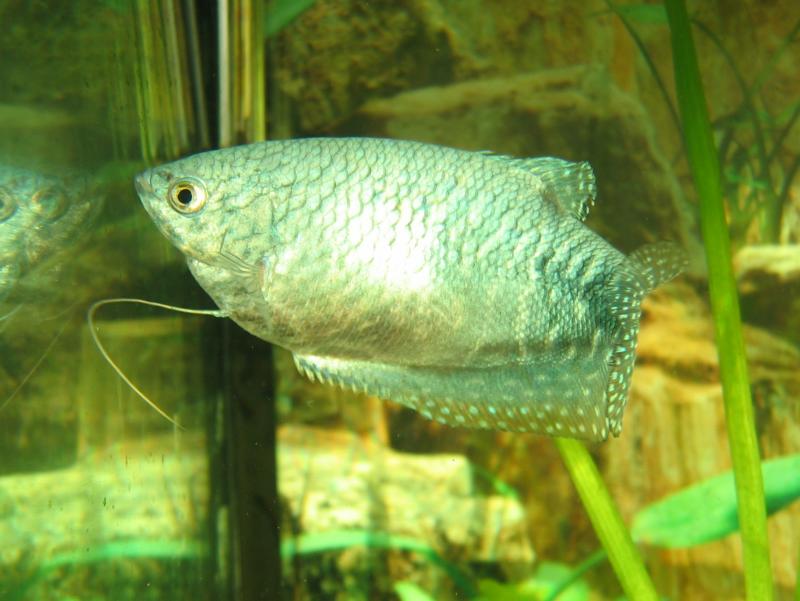|
| Query: Gourami | Result: 1st of 60 | |
Three-spot Gourami (Trichogaster trichopterus) - Wiki
| Subject: | Three-spot Gourami (Trichogaster trichopterus) - Wiki
| |

| Resolution: 800x601
File Size: 61014 Bytes
Date: 2004:09:26 09:00:01
Camera: Canon PowerShot A80 (Canon)
F number: f/2.8
Exposure: 1/80 sec
Focal Length: 250/32
Upload Date: 2007:08:16 14:21:06
|
Three spot gourami
From Wikipedia, the free encyclopedia
[Photo] Blue gourami (Trichogaster trichopterus). Author Rafal Konkolewski 2004.
The three spot gourami, Trichogaster trichopterus, is a labyrinth fish. The natural coloration of this fish gets its name from the two spots along each side of its body in line with the eye, considered the third spot. Marketed fresh or salted and pickled, they are also popular in the fishkeeping hobby, commonly kept in aquariums. Depending on the various artificial color morphs, the species may be known under other common names including the Blue gourami, Cosby gourami, Gold gourami, Golden gourami, and the Opaline gourami.
Distribution and ecology
Three spot gourami are endemic to the Mekong basin in Cambodia, Laos, Thailand and Vietnam and Yunnan in southeast Asia. These fish live in marshes, swamps, canals, and lowland wetlands. They migrate during the flood season from permanent water bodies to flooded areas, such as seasonally flooded forests in the middle and lower Mekong. During the dry season, they will return to these permanent water bodies. These fish feed on zooplankton, crustaceans and insect larvae. The male builds a bubble nest for the eggs, which he protects aggressively.
In the aquarium
The Three spot gourami is a hardy fish. This species can be housed with a variety of tank mates that are of similar size and temperament. While males can be territorial with each other, they become timid around other, more aggressive fish. The ideal tank set-up would be an aquarium of a minimum of 20 gallons and have plenty of live plants as well as rocks and driftwood for use as hiding places.
Feeding
The Three spot gourami is an omnivore and requires both algae-based foods as well as meaty foods. An algae-based flake food, along with freeze-dried bloodworms, tubifex worms, and brine shrimp will provide these fish with the proper nutrition. The average weight of a blue gourami is 2-3.5 ounces.
Breeding
The best way to differentiate between the male and female Three spot gourami is by the dorsal fin. In the male, the dorsal fin is long and pointed, while the female's is shorter and rounded. For breeding, the temperature should be aboue 26°C (78°F). When ready to breed, the male builds a bubble nest and then begins to entice the female by swimming back and forth, flaring his fins and raising his tail. When this behavior is noticed, the water level should be reduced to 6 inches. The depth is not extremely important as it is in other labyrinth fish. The female may lay up to 700 to 800 eggs. After spawning the female should be removed to a separate aquarium as the male may become aggressive toward her. The male protects the eggs and fry, but should be removed after they become free-swimming. After hatching, there should be frequent water changes, especially during the third week, as this is when the labyrinth organ is developing. The fry should be fed infusoria and nauplii.
http://en.wikipedia.org/wiki/Three_spot_gourami
| The text in this page is based on the copyrighted Wikipedia article shown in above URL. It is used under the GNU Free Documentation License. You may redistribute it, verbatim or modified, providing that you comply with the terms of the GFDL. |
|
Comments |
|---|
| | rhodnar |
|
| panget ka |
| | american |
|
| i have a three spot gourami she has a small belly . and ever time the male sees her he attacs her on her small bell . why and i will like to know when she lays her eggs. if please more info about the gouramis .plezz answer to day. |
^o^
Animal Pictures Archive for smart phones
^o^
|
|
|

